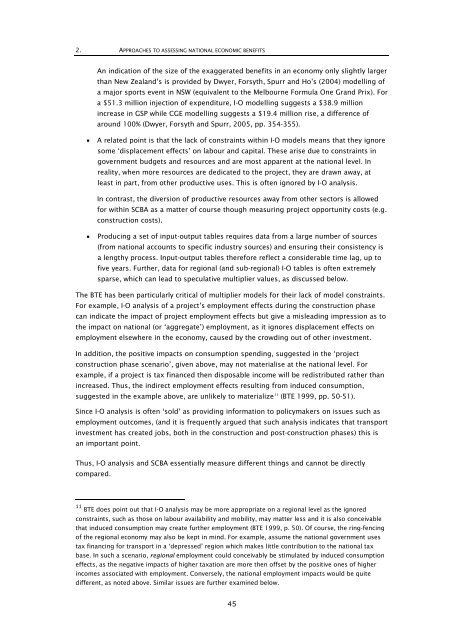Research 350 - NZ Transport Agency
Research 350 - NZ Transport Agency
Research 350 - NZ Transport Agency
You also want an ePaper? Increase the reach of your titles
YUMPU automatically turns print PDFs into web optimized ePapers that Google loves.
2. APPROACHES TO ASSESSING NATIONAL ECONOMIC BENEFITS<br />
An indication of the size of the exaggerated benefits in an economy only slightly larger<br />
than New Zealand’s is provided by Dwyer, Forsyth, Spurr and Ho’s (2004) modelling of<br />
a major sports event in NSW (equivalent to the Melbourne Formula One Grand Prix). For<br />
a $51.3 million injection of expenditure, I-O modelling suggests a $38.9 million<br />
increase in GSP while CGE modelling suggests a $19.4 million rise, a difference of<br />
around 100% (Dwyer, Forsyth and Spurr, 2005, pp. 354-355).<br />
• A related point is that the lack of constraints within I-O models means that they ignore<br />
some ‘displacement effects’ on labour and capital. These arise due to constraints in<br />
government budgets and resources and are most apparent at the national level. In<br />
reality, when more resources are dedicated to the project, they are drawn away, at<br />
least in part, from other productive uses. This is often ignored by I-O analysis.<br />
In contrast, the diversion of productive resources away from other sectors is allowed<br />
for within SCBA as a matter of course though measuring project opportunity costs (e.g.<br />
construction costs).<br />
• Producing a set of input-output tables requires data from a large number of sources<br />
(from national accounts to specific industry sources) and ensuring their consistency is<br />
a lengthy process. Input-output tables therefore reflect a considerable time lag, up to<br />
five years. Further, data for regional (and sub-regional) I-O tables is often extremely<br />
sparse, which can lead to speculative multiplier values, as discussed below.<br />
The BTE has been particularly critical of multiplier models for their lack of model constraints.<br />
For example, I-O analysis of a project’s employment effects during the construction phase<br />
can indicate the impact of project employment effects but give a misleading impression as to<br />
the impact on national (or ‘aggregate’) employment, as it ignores displacement effects on<br />
employment elsewhere in the economy, caused by the crowding out of other investment.<br />
In addition, the positive impacts on consumption spending, suggested in the ‘project<br />
construction phase scenario’, given above, may not materialise at the national level. For<br />
example, if a project is tax financed then disposable income will be redistributed rather than<br />
increased. Thus, the indirect employment effects resulting from induced consumption,<br />
suggested in the example above, are unlikely to materialize 11 (BTE 1999, pp. 50-51).<br />
Since I-O analysis is often ‘sold’ as providing information to policymakers on issues such as<br />
employment outcomes, (and it is frequently argued that such analysis indicates that transport<br />
investment has created jobs, both in the construction and post-construction phases) this is<br />
an important point.<br />
Thus, I-O analysis and SCBA essentially measure different things and cannot be directly<br />
compared.<br />
11 BTE does point out that I-O analysis may be more appropriate on a regional level as the ignored<br />
constraints, such as those on labour availability and mobility, may matter less and it is also conceivable<br />
that induced consumption may create further employment (BTE 1999, p. 50). Of course, the ring-fencing<br />
of the regional economy may also be kept in mind. For example, assume the national government uses<br />
tax financing for transport in a ‘depressed’ region which makes little contribution to the national tax<br />
base. In such a scenario, regional employment could conceivably be stimulated by induced consumption<br />
effects, as the negative impacts of higher taxation are more then offset by the positive ones of higher<br />
incomes associated with employment. Conversely, the national employment impacts would be quite<br />
different, as noted above. Similar issues are further examined below.<br />
45
















